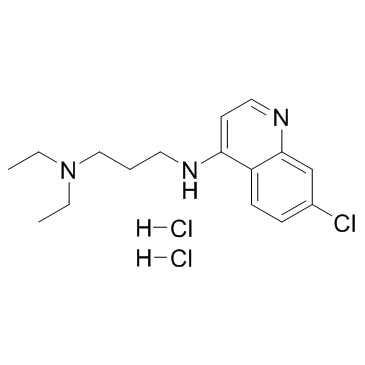AQ-13 dihydrochloride
Modify Date: 2024-01-15 18:22:01

AQ-13 dihydrochloride structure
|
Common Name | AQ-13 dihydrochloride | ||
|---|---|---|---|---|
| CAS Number | 169815-40-1 | Molecular Weight | 364.74100 | |
| Density | N/A | Boiling Point | N/A | |
| Molecular Formula | C16H24Cl3N3 | Melting Point | N/A | |
| MSDS | N/A | Flash Point | N/A | |
Use of AQ-13 dihydrochlorideAQ-13 dihydrochloride is an aminoquinoline antimalarial drug that is effective against chloroquine-resistant strains of Plasmodium falciparum. |
| Name | N-(7-chloroquinolin-4-yl)-N',N'-diethylpropane-1,3-diamine,dihydrochloride |
|---|---|
| Synonym | More Synonyms |
| Description | AQ-13 dihydrochloride is an aminoquinoline antimalarial drug that is effective against chloroquine-resistant strains of Plasmodium falciparum. |
|---|---|
| Related Catalog | |
| In Vivo | Slight decreases in the PCE/RBC ratio are observed in male and female rats treated with CQ and in females only treated with AQ-13; however, none of these changes is statistically significant[1]. |
| Animal Admin | Rats[1] Male and female Sprague-Dawley rats are used and are 8-9 weeks of age at the time of dose administration. Micronucleus evaluations are conducted in conjunction with repeatdose toxicity studies. Rats are orally administered AQ-13 or CQ in water. Rats are given a “loading dose” followed by maintenance doses of one-half the loading dose administered 12 hr later and daily thereafter for 6 additional days[1]. |
| References |
| Molecular Formula | C16H24Cl3N3 |
|---|---|
| Molecular Weight | 364.74100 |
| Exact Mass | 363.10400 |
| PSA | 28.16000 |
| LogP | 5.70900 |
| Storage condition | 2-8℃ |
| AQ 13 |
| 1,3-Propanediamine,N'-(7-chloro-4-quinolinyl)-N,N-diethyl-,dihydrochloride |
| (N1-(7-Chloroquinolin-4-yl)-3-(N3,N3-diethylamino)propylamine) dihydrochloride |